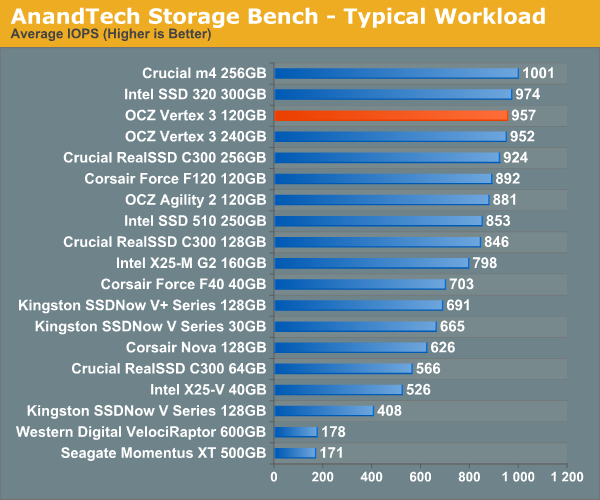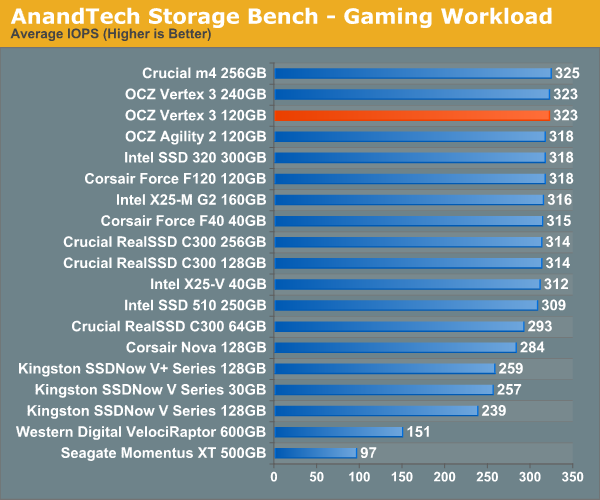The OCZ Vertex 3 Review (120GB)
by Anand Lal Shimpi on April 6, 2011 6:32 PM ESTAnandTech Storage Bench 2010
To keep things consistent we've also included our older Storage Bench. Note that the old storage test system doesn't have a SATA 6Gbps controller, so we only have one result for the 6Gbps drives.
The first in our benchmark suite is a light/typical usage case. The Windows 7 system is loaded with Firefox, Office 2007 and Adobe Reader among other applications. With Firefox we browse web pages like Facebook, AnandTech, Digg and other sites. Outlook is also running and we use it to check emails, create and send a message with a PDF attachment. Adobe Reader is used to view some PDFs. Excel 2007 is used to create a spreadsheet, graphs and save the document. The same goes for Word 2007. We open and step through a presentation in PowerPoint 2007 received as an email attachment before saving it to the desktop. Finally we watch a bit of a Firefly episode in Windows Media Player 11.
There’s some level of multitasking going on here but it’s not unreasonable by any means. Generally the application tasks proceed linearly, with the exception of things like web browsing which may happen in between one of the other tasks.
The recording is played back on all of our drives here today. Remember that we’re isolating disk performance, all we’re doing is playing back every single disk access that happened in that ~5 minute period of usage. The light workload is composed of 37,501 reads and 20,268 writes. Over 30% of the IOs are 4KB, 11% are 16KB, 22% are 32KB and approximately 13% are 64KB in size. Less than 30% of the operations are absolutely sequential in nature. Average queue depth is 6.09 IOs.
The performance results are reported in average I/O Operations per Second (IOPS):

If there’s a light usage case there’s bound to be a heavy one. In this test we have Microsoft Security Essentials running in the background with real time virus scanning enabled. We also perform a quick scan in the middle of the test. Firefox, Outlook, Excel, Word and Powerpoint are all used the same as they were in the light test. We add Photoshop CS4 to the mix, opening a bunch of 12MP images, editing them, then saving them as highly compressed JPGs for web publishing. Windows 7’s picture viewer is used to view a bunch of pictures on the hard drive. We use 7-zip to create and extract .7z archives. Downloading is also prominently featured in our heavy test; we download large files from the Internet during portions of the benchmark, as well as use uTorrent to grab a couple of torrents. Some of the applications in use are installed during the benchmark, Windows updates are also installed. Towards the end of the test we launch World of Warcraft, play for a few minutes, then delete the folder. This test also takes into account all of the disk accesses that happen while the OS is booting.
The benchmark is 22 minutes long and it consists of 128,895 read operations and 72,411 write operations. Roughly 44% of all IOs were sequential. Approximately 30% of all accesses were 4KB in size, 12% were 16KB in size, 14% were 32KB and 20% were 64KB. Average queue depth was 3.59.

The gaming workload is made up of 75,206 read operations and only 4,592 write operations. Only 20% of the accesses are 4KB in size, nearly 40% are 64KB and 20% are 32KB. A whopping 69% of the IOs are sequential, meaning this is predominantly a sequential read benchmark. The average queue depth is 7.76 IOs.











153 Comments
View All Comments
Xcellere - Wednesday, April 6, 2011 - link
It's too bad the lower capacity drives aren't performing as well as the 240 GB version. I don't have a need for a single high capacity drive so the expenditure in added space is unnecessary for me. Oh well, that's what you get for wanting bleeding-edge tech all the time.Kepe - Wednesday, April 6, 2011 - link
If I've understood correctly, they're using 1/2 of the NAND devices to cut drive capacity from 240 GB to 120 GB.My question is: why don't they use the same amount of NAND devices with 1/2 the capacity instead? Again, if I have understood correctly, that way the performance would be identical compared to the higher capacity model.
Is NAND produced in only one capacity packages or is there some other reason not to use NAND devices of differing capacities?
dagamer34 - Wednesday, April 6, 2011 - link
Because price scaling makes it more cost-effective to use fewer, more dense chips than separate smaller, less dense chips as the more chips made, the cheaper they eventually become.Like Anand said, this is why you can't just as for a 90nm CPU today, it's just too old and not worth making anymore. This is also why older memory gets more expensive when it's not massively produced anymore.
Kepe - Wednesday, April 6, 2011 - link
But couldn't they just make smaller dies? Just like there are different sized CPU/GPU dies for different amounts of performance. Cut the die size in half, fit 2x the dies per wafer, sell for 50% less per die than the large dies (i.e. get the same amount of money per wafer).A5 - Wednesday, April 6, 2011 - link
No reason for IMFT to make smaller dies - they sell all of the large dies coming out of the fab (whether to themselves or 3rd parties), so why bother making a smaller one?vol7ron - Wednesday, April 6, 2011 - link
You're missing the point on economies of scale.Having one size means you don't have leftover parts, or have to pay for a completely different process (which includes quality control).
These things are already expensive, adding the logistical complexity would only drive the prices up. Especially, since there are noticeable difference in the manufacturing process.
I guess they could take the poorer performing silicon and re-market them. Like how Anand mentioned that they take poorer performning GPUs and just sell them at a lower clockrate/memory capacity, but it could be that the NAND production is more refined and doesn't have that large of a difference.
Regardless, I think you mentioned the big point: inner RAIDs improve performance. Why 8 chips, why not more? Perhaps heat has something to do with it, and (of course) power would be the other reason, but it would be nice to see higher performing, more power-hungry SSDs. There may also be a performance benefit in larger chips too, though, sort of like DRAM where 1x2GB may perform better than 2x1GB (not interlaced).
I'm still waiting for the manufacturers to get fancy, perhaps with multiple controllers and speedier DRAM. Where's the Vertex3 Colossus.
marraco - Tuesday, April 12, 2011 - link
Smaller dies would improve yields, and since they could enable full speed, it would be more competitive.A bigger chip with a flaw may invalidate the die, but if divided in two smaller chips it would recover part of it.
On other side, probably yields are not as big problem, since bad sectors can be replaced with good ones by the controller.
Kepe - Wednesday, April 6, 2011 - link
Anand, I'd like to thank you on behalf of pretty much every single person on the planet. You're doing an amazing job with making companies actually care about their customers and do what is right.Thank you so much, and keep up the amazing work.
- Kepe
dustofnations - Wednesday, April 6, 2011 - link
Thank God for a consumer advocate with enough clout for someone important to listen to them.All too often valid and important complaints fall at the first hurdle due to dumb PR/CS people who filter out useful information. Maybe this is because they assume their customers are idiots, or that it is too much hassle, or perhaps don't have the requisite technical knowledge to act sensibly upon complex complaints.
Kepe - Wednesday, April 6, 2011 - link
I'd say the reason is usually that when a company has sold you its product, they suddenly lose all interest in you until they come up with a new product to sell. Apple used to be a very good example with its battery policy. "So, your battery died? We don't sell new or replace dead batteries, but you can always buy the new, better iPod."It's this kind of ignorance towards the consumers that is absolutely appalling, and Anand is doing a great job at fighting for the consumer's rights. He should get some sort of an award for all he has done.